Gully Erosion Control Practices in Northeast China: A Review
Abstract
1. Introduction
2. Two Systems of Gully Erosion Management
3. Drop Structures of Controlling Headcuts
3.1. Arc-Reinforced Concrete and Diversion Masonry Drop Structures
3.2. Masonry Drop Structures for Medium-Sized and Large-Sized Gullies
3.3. Drop Structures with Different Sizes of Gabion
4. Check Dam Practices of Controlling Gully Bed
4.1. Soil Check Dam
4.2. Masonry Check Dam
4.3. Gabion Check Dam
4.4. Wicker Check Dam
5. Vegetation Rehabilitation for Gully Erosion
5.1. Continuous Live Wicker
5.2. Shrub Plant Enclosure
5.3. Arbor Plant Enclosure
6. Discussion
7. Conclusions
Author Contributions
Funding
Conflicts of Interest
References
- Valentin, C.; Poesen, J.; Li, Y. Gully erosion: Impacts, factors and control. Catena 2005, 63, 132–153. [Google Scholar] [CrossRef]
- Simon, A.; Pollen-Bankhead, N.; Thomas, R.E. Development and application of a deterministic bank stability and toe erosion model for stream restoration. Stream Restor. Dyn. Fluv. Syst. 2011, 453–474. [Google Scholar] [CrossRef]
- Ionita, I.; Fullen, M.A.; Zgłobicki, W.; Poesen, J. Gully Erosion as a Natural and Human-Induced Hazard; Springer: Berlin/Heidelberg, Germany, 2015. [Google Scholar]
- Shellberg, J.; Spencer, J.; Brooks, A.; Pietsch, T. Degradation of the Mitchell River fluvial megafan by alluvial gully erosion increased by post-European land use change, Queensland, Australia. Geomorphology 2016, 266, 105–120. [Google Scholar] [CrossRef]
- Liu, X.; Zhang, X. Gully erosion: Diversity, processes and prospects. Soils Crops 2018, 7, 13. [Google Scholar] [CrossRef]
- Chalise, D.; Kumar, L.; Kristiansen, P. Land degradation by soil erosion in Nepal: A review. Soil Syst. 2019, 3, 12. [Google Scholar] [CrossRef]
- Takken, I.; Croke, J.; Lane, P. Thresholds for channel initiation at road drain outlets. Catena 2008, 75, 257–267. [Google Scholar] [CrossRef]
- Ma, H.; Zhao, H. United Nations: Convention to combat desertification in those countries experiencing serious drought and/or desertification, particularly in Africa. Int. Leg. Mater. 1994, 33, 1328–1382. [Google Scholar] [CrossRef]
- Lal, R. Soil degradation by erosion. Land Degrad. Dev. 2001, 12, 519–539. [Google Scholar] [CrossRef]
- Yitbarek, T.; Belliethathan, S.; Stringer, L. The onsite cost of gully erosion and cost-benefit of gully rehabilitation: A case study in Ethiopia. Land Degrad. Dev. 2012, 23, 157–166. [Google Scholar] [CrossRef]
- Kidane, D.; Alemu, B. The effect of upstream land use practices on soil erosion and sedimentation in the Upper Blue Nile Basin, Ethiopia. Res. J. Agric. Environ. Manag. 2015, 4, 55–68. [Google Scholar]
- Ayele, G.K.; Gessess, A.A.; Addisie, M.B.; Tilshun, S.A.; Tenessa, D.B.; Langendoen, E.J.; Steenhuis, T.S.; Nicholson, C.F. The economic cost of upland and gully erosion on subsistence agriculture for a watershed in the Ethiopian highlands. Afr. J. Agric. Resour. Econ. 2015, 10, 265. [Google Scholar]
- Mararakanye, N.; Sumner, P.D. Gully erosion: A comparison of contributing factors in two catchments in South Africa. Geomorphology 2017, 288, 99–110. [Google Scholar] [CrossRef]
- Zegeye, A.D.; Langendoen, E.J.; Guzman, C.D.; Dagnew, D.C.; Amare, S.D.; Tilahun, S.A.; Steenhuis, T.S. Gullies, a critical link in landscape soil loss: A case study in the subhumid highlands of Ethiopia. Land Degrad. Dev. 2018, 29, 1222–1232. [Google Scholar] [CrossRef]
- Chalise, D.; Kumar, L.; Shriwastav, C.P.; Lamichhane, S. Spatial assessment of soil erosion in a hilly watershed of Western Nepal. Environ. Earth Sci. 2018, 77, 685. [Google Scholar] [CrossRef]
- Liu, X.; Zhang, X.; Wang, Y.; Sui, Y.; Zhang, S.; Herbert, S.; Ding, G. Soil degradation: A problem threatening the sustainable development of agriculture in Northeast China. Plant Soil Environ. 2010, 56, 87–97. [Google Scholar] [CrossRef]
- Liu, X.; Lee Burras, C.; Kravchenko, Y.S.; Duran, A.; Huffman, T.; Morras, H.; Studdert, G.; Zhang, X.; Cruse, R.M.; Yuan, X. Overview of Mollisols in the world: Distribution, land use and management. Can. J. Soil Sci. 2012, 92, 383–402. [Google Scholar] [CrossRef]
- Li, W.; Zhang, P.; Song, Y. Analysis on Land Development and Causes in Northeast China during Qing Dynasty. Sci. Geogr. Sin. 2005, 25, 7–16. [Google Scholar] [CrossRef]
- Zhang, X.; Liang, A.; Shen, Y. Erosion characteristics of black soils in Northeast China. Sci. Geogr. Sin. 2006, 26, 692. [Google Scholar]
- Song, Y. Eco-environment protection and construction of green community in northeast China. Sci. Geogr. Sin./Dili Kexue 2002, 22, 659–668. [Google Scholar] [CrossRef]
- Liu, B.; Yan, B.; Shen, B.; Wang, Z.; Wei, X. Current status and comprehensive control strategies of soil erosion for cultivated land in the Northeastern black soil area of China. Sci. Soil Water Conserv. 2008, 6, 8. [Google Scholar] [CrossRef]
- Fan, H.; Gu, G.; Wang, Y. Characteristics of eroded gully development and environment of black soil region in Northeast China. Soil Water Conserv. China 2013, 10, 75–79. [Google Scholar] [CrossRef]
- Li, Z.; Wang, Y.; Liu, X.; Liu, J. Survey methods and results of erosion gullies in black soil areas of northeastern China. Sci. Soil Water Conserv. 2013, 11, 5. [Google Scholar] [CrossRef]
- Bai, J.; Hui, L. Preliminary investigation on gully development and harm in Black Soil Region of Northeast China. Soil Water Conserv. China 2015, 8, 3. [Google Scholar] [CrossRef]
- Wang, Y.; Xie, Y.; Wang, P. Analysis on the causes of soil erosion in black soil region of Northeast China. Sci. Tech. Inf. Soil Water Conserv. 2002, 3, 27–29. [Google Scholar] [CrossRef]
- Wang, W.; Zhang, S.; Deng, R. Gully status and relationship with landscape pattern in black soil area of Northeast China. Trans. Chin. Soc. Agric. Eng. 2011, 27, 192–198. [Google Scholar] [CrossRef]
- Liu, X.; Yan, B. Soil erosion and food security in Northeast China. Chin. J. Soil Water Conserv. 2009, 1, 17–19. [Google Scholar] [CrossRef]
- Yang, J.; Zhang, S.; Chang, L.; Li, F.; Li, T.; Gao, Y. Gully erosion regionalization of black soil area in northeastern China. Chin. Geogr. Sci. 2017, 27, 78–87. [Google Scholar] [CrossRef]
- Zhang, X.; Hui, L. The Achievement of Comprehensive Soil Erosion Control in Northeast China; China Water Power Press: Beijing, China, 2015. [Google Scholar]
- Ceballos, A.; Cerda, A.; Schnabel, S. Runoff production and erosion processes on a dehesa in western Spain. Geogr. Rev. 2002, 92, 333–353. [Google Scholar] [CrossRef]
- Poesen Vandekerckhove, L.; Nachtergaele, J.; Oostwoud Wijdenes, D.; Verstraeten, G.; Van Wesmael, B. Gully Erosion in Dryland Environments. Dryland Rivers: Hydrology and Geomorphology of Semi-Arid; John Wiley Sons Ltd.: Chichester, UK, 2002. [Google Scholar]
- Toy, T.J.; Foster, G.R.; Renard, K.G. Soil Erosion: Processes, Prediction, Measurement, and Control; John Wiley Sons: Hoboken, NJ, USA, 2002. [Google Scholar]
- Ziadat, F.M.; Taimeh, A. Effect of rainfall intensity, slope, land use and antecedent soil moisture on soil erosion in an arid environment. Land Degrad. Dev. 2013, 24, 582–590. [Google Scholar] [CrossRef]
- SSAJ. Glossary of Soil Science Terms 2008; The American Society of Agronomy-Crop Science Society of America-Soil Science Society of America: Madison, WI, USA, 2008. [Google Scholar]
- Frankl, A.; Poesen, J.; Haile, M.; Deckers, J.; Nyssen, J. Quantifying long-term changes in gully networks and volumes in dryland environments: The case of Northern Ethiopia. Geomorphology 2013, 201, 254–263. [Google Scholar] [CrossRef]
- Huang, J.; Hinokidani, O.; Yasuda, H.; Ojha, C.S.; Kajikawa, Y.; Li, S. Effects of the check dam system on water redistribution in the Chinese Loess Plateau. J. Hydrol. Eng. 2012, 18, 929–940. [Google Scholar] [CrossRef]
- Nyssen, J.; Veyret-Picot, M.; Poesen, J.; Moeyersons, J.; Haile, M.; Deckers, J.; Govers, G. The effectiveness of loose rock check dams for gully control in Tigray, northern Ethiopia. Soil Use Manag. 2004, 20, 55–64. [Google Scholar] [CrossRef]
- Borja, P.; Molina, A.; Govers, G.; Vanacker, V. Check dams and afforestation reducing sediment mobilization in active gully systems in the Andean mountains. Catena 2018, 165, 42–53. [Google Scholar] [CrossRef]
- Castillo, V.; Mosch, W.; García, C.C.; Barberá, G.; Cano, J.N.; López-Bermúdez, F. Effectiveness and geomorphological impacts of check dams for soil erosion control in a semiarid Mediterranean catchment: El Cárcavo (Murcia, Spain). Catena 2007, 70, 416–427. [Google Scholar] [CrossRef]
- Hassanli, A.M.; Nameghi, A.E.; Beecham, S. Evaluation of the effect of porous check dam location on fine sediment retention (a case study). Environ. Monit. Assess. 2009, 152, 319–326. [Google Scholar] [CrossRef] [PubMed]
- Nyssen, J.; Clymans, W.; Descheemaeker, K.; Poesen, J.; Vandecasteele, I.; Vanmaercke, M.; Zenebe, A.; Van Camp, M.; Haile, M.; Haregeweyn, N. Impact of soil and water conservation measures on catchment hydrological response—A case in north Ethiopia. Hydrol. Process. 2010, 24, 1880–1895. [Google Scholar] [CrossRef]
- Polyakov, V.; Nichols, M.; McClaran, M.; Nearing, M. Effect of check dams on runoff, sediment yield, and retention on small semiarid watersheds. J. Soil Water Conserv. 2014, 69, 414–421. [Google Scholar] [CrossRef]
- Remaître, A.; Van Asch, T.W.; Malet, J.-P.; Maquaire, O. Influence of check dams on debris-flow run-out intensity. Nat. Hazards Earth Syst. Sci. 2008, 8, 1403–1416. [Google Scholar] [CrossRef]
- Xu, X.; Zhang, H.; Zhang, O. Development of check-dam systems in gullies on the Loess Plateau, China. Environ. Sci. Policy 2004, 7, 79–86. [Google Scholar] [CrossRef]
- Feng, G. The key to bring the Yellow River under control is to speed up construction of check-dams in the Sandy and Grit Areas. Sci. Technol. Rev. 2000, 145, 53–57. [Google Scholar] [CrossRef]
- Ran, D.; Luo, Q.; Zhou, Z.; Wang, G.; Zhang, X. Sediment retention by check dams in the Hekouzhen-Longmen Section of the Yellow River. Int. J. Sediment Res. 2008, 23, 159–166. [Google Scholar] [CrossRef]
- Atreya, K.; Sharma, S.; Bajracharya, R.M.; Rajbhandari, N.P. Developing a sustainable agro-system for central Nepal using reduced tillage and straw mulching. J. Environ. Manag. 2008, 88, 547–555. [Google Scholar] [CrossRef]
- Assefa, E.; Hans-Rudolf, B. Farmers’ perception of land degradation and traditional knowledge in Southern Ethiopia—resilience and stability. Land Degrad. Dev. 2016, 27, 1552–1561. [Google Scholar]
- Porto, P.; Gessler, J. Ultimate bed slope in Calabrian streams upstream of check dams: Field study. J. Hydraul. Eng. 1999, 125, 1231–1242. [Google Scholar] [CrossRef]
- Boix-Fayos, C.; de Vente, J.; Martínez-Mena, M.; Barberá, G.G.; Castillo, V. The impact of land use change and check-dams on catchment sediment yield. Hydrol. Process. Int. J. 2008, 22, 4922–4935. [Google Scholar] [CrossRef]
- Bewket, W. Soil and water conservation intervention with conventional technologies in northwestern highlands of Ethiopia: Acceptance and adoption by farmers. Land Use Policy 2007, 24, 404–416. [Google Scholar] [CrossRef]
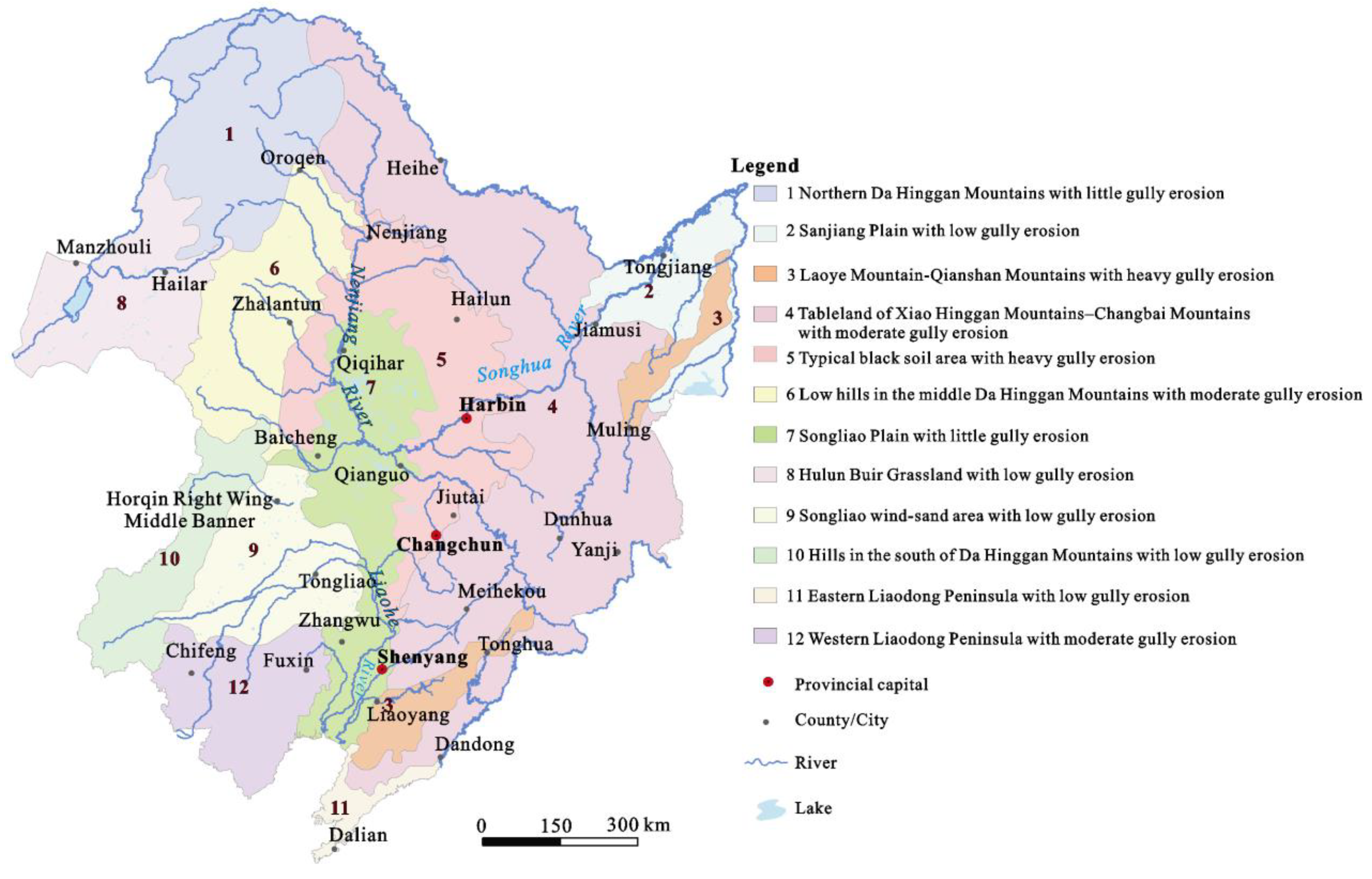

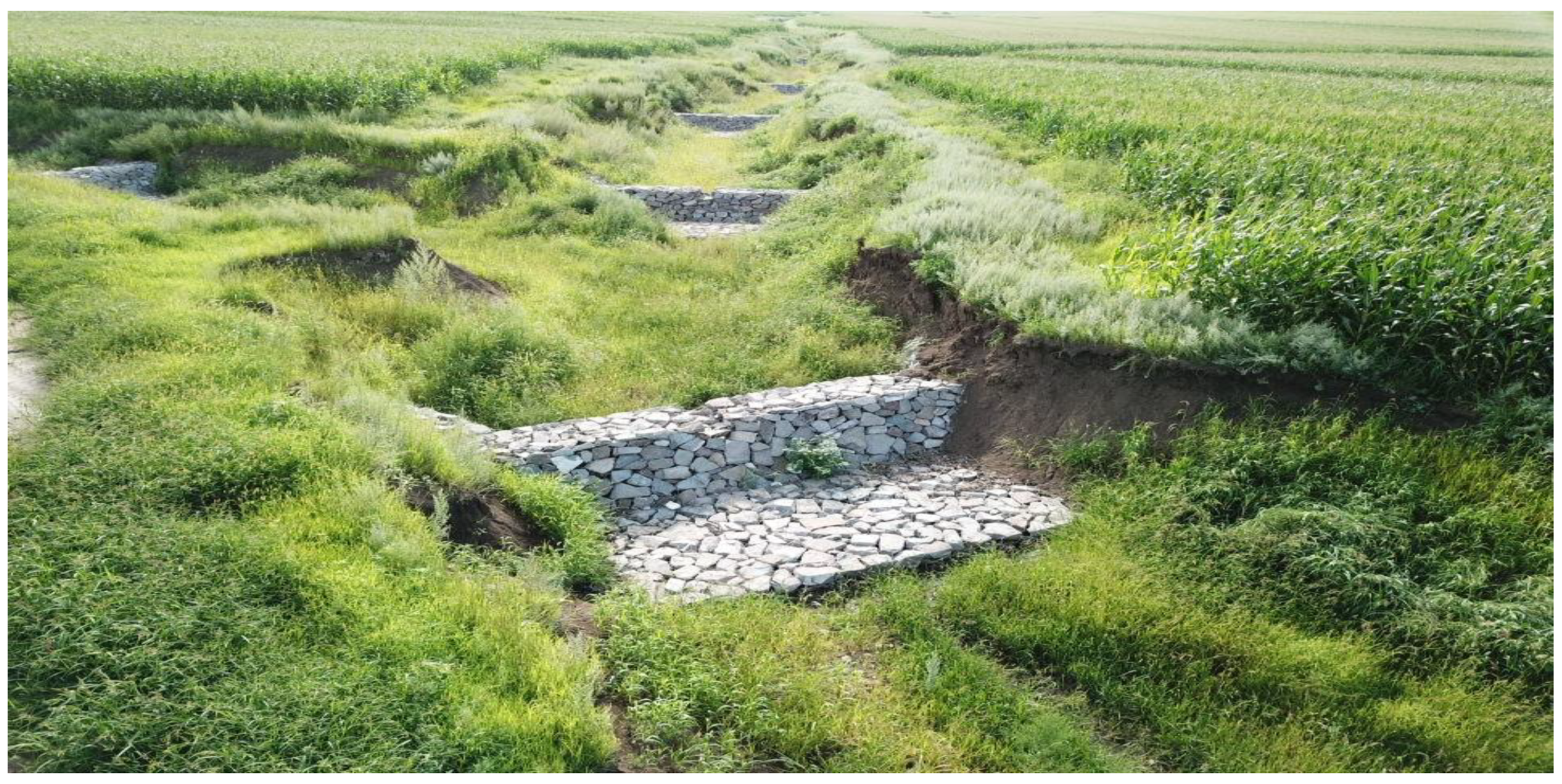
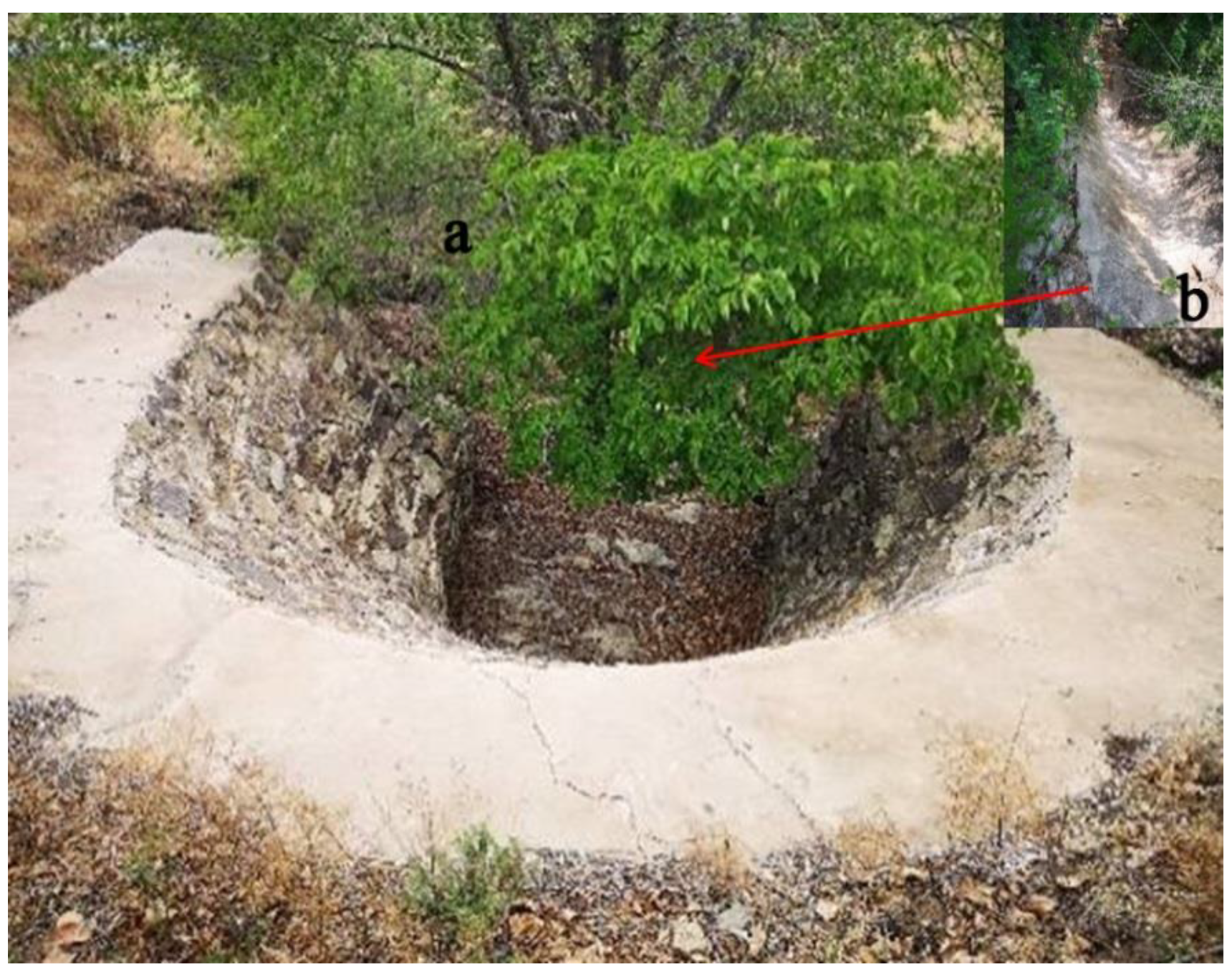



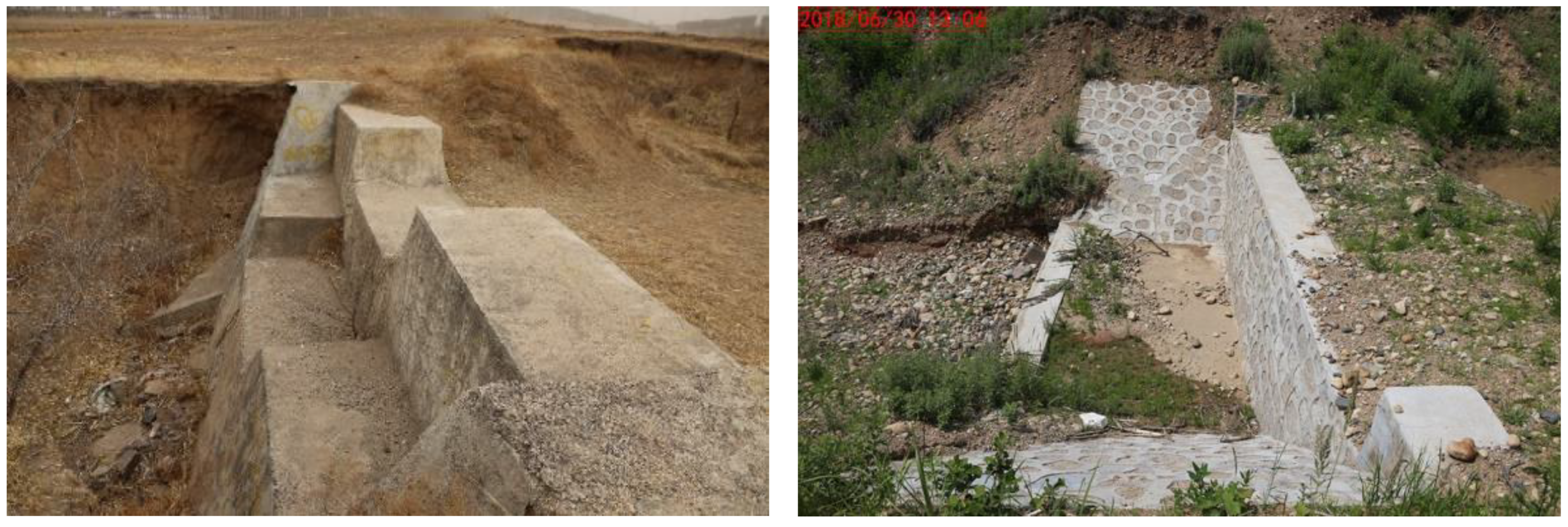
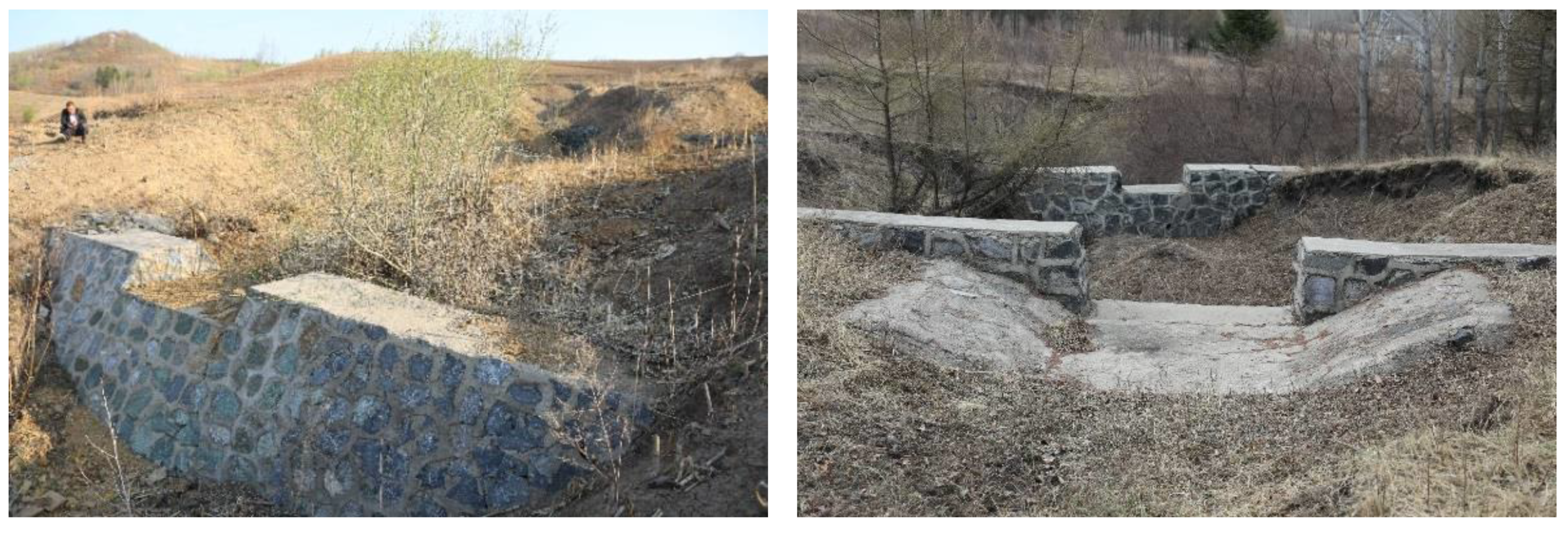

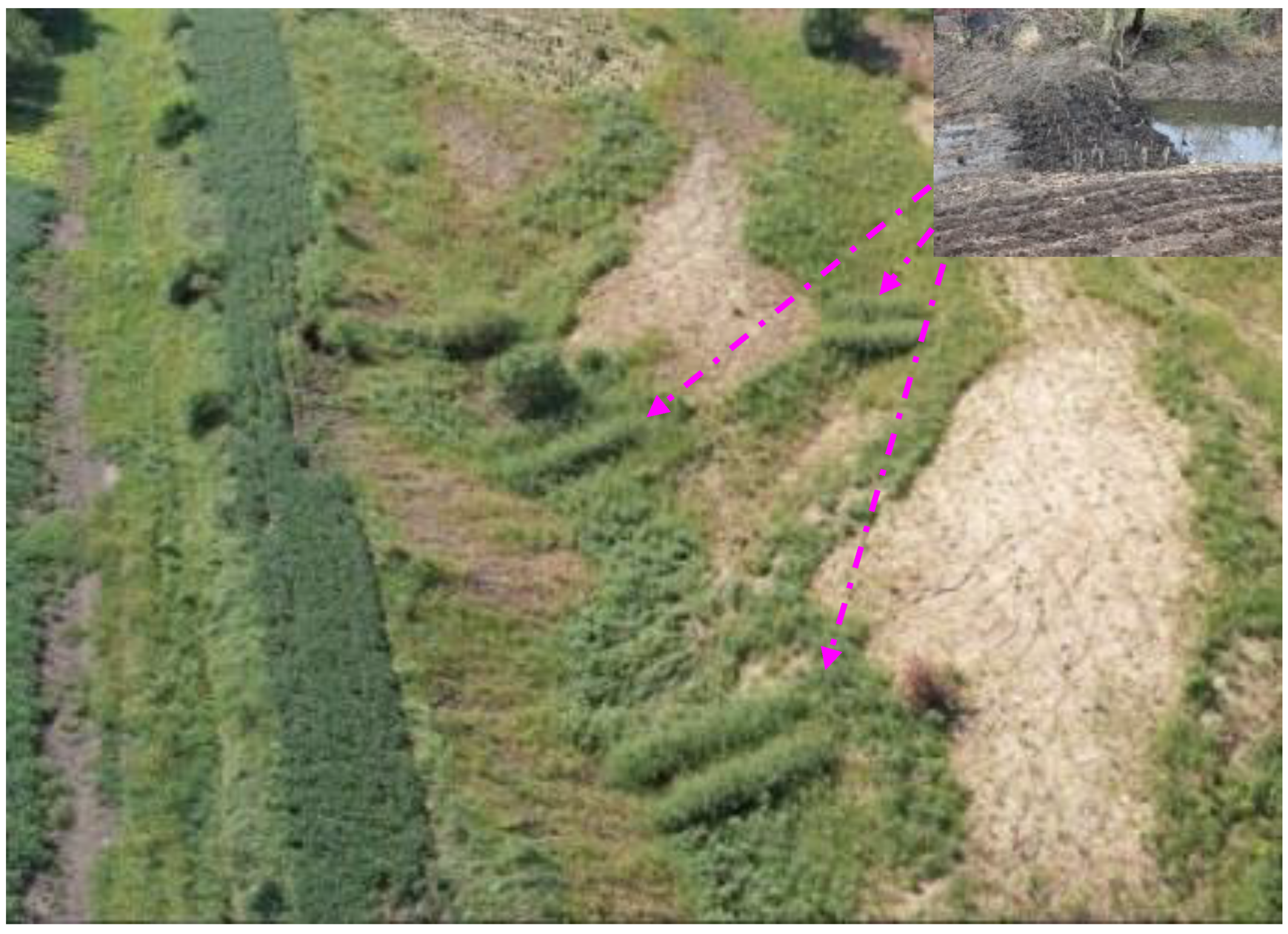
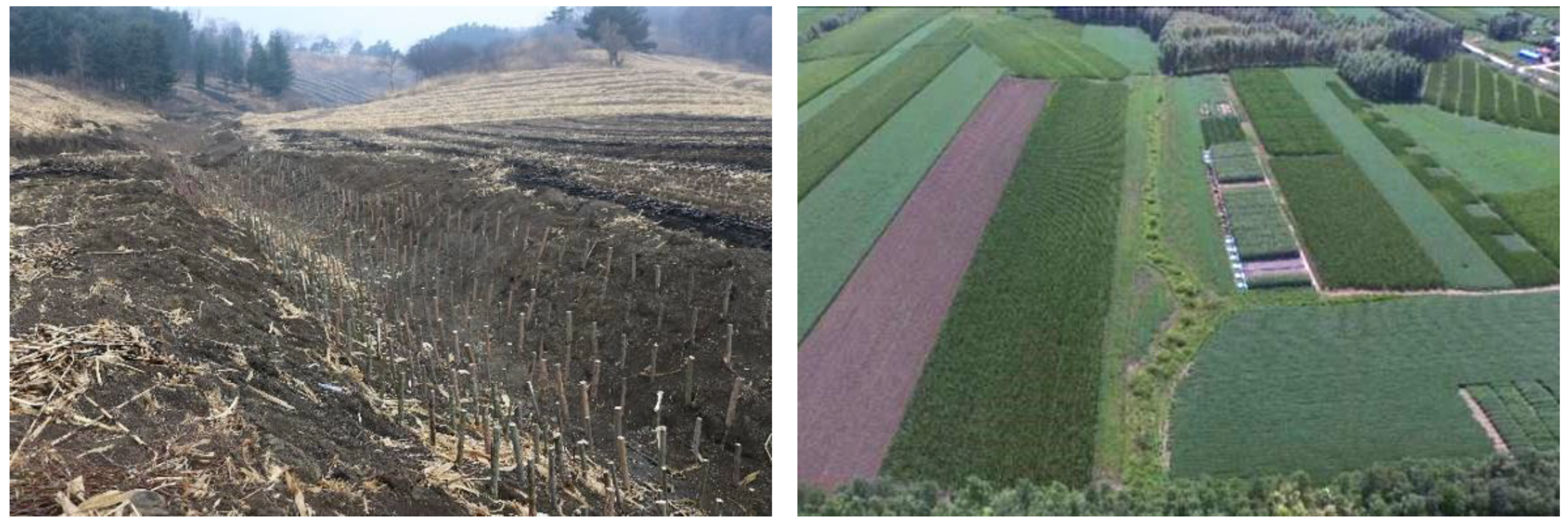
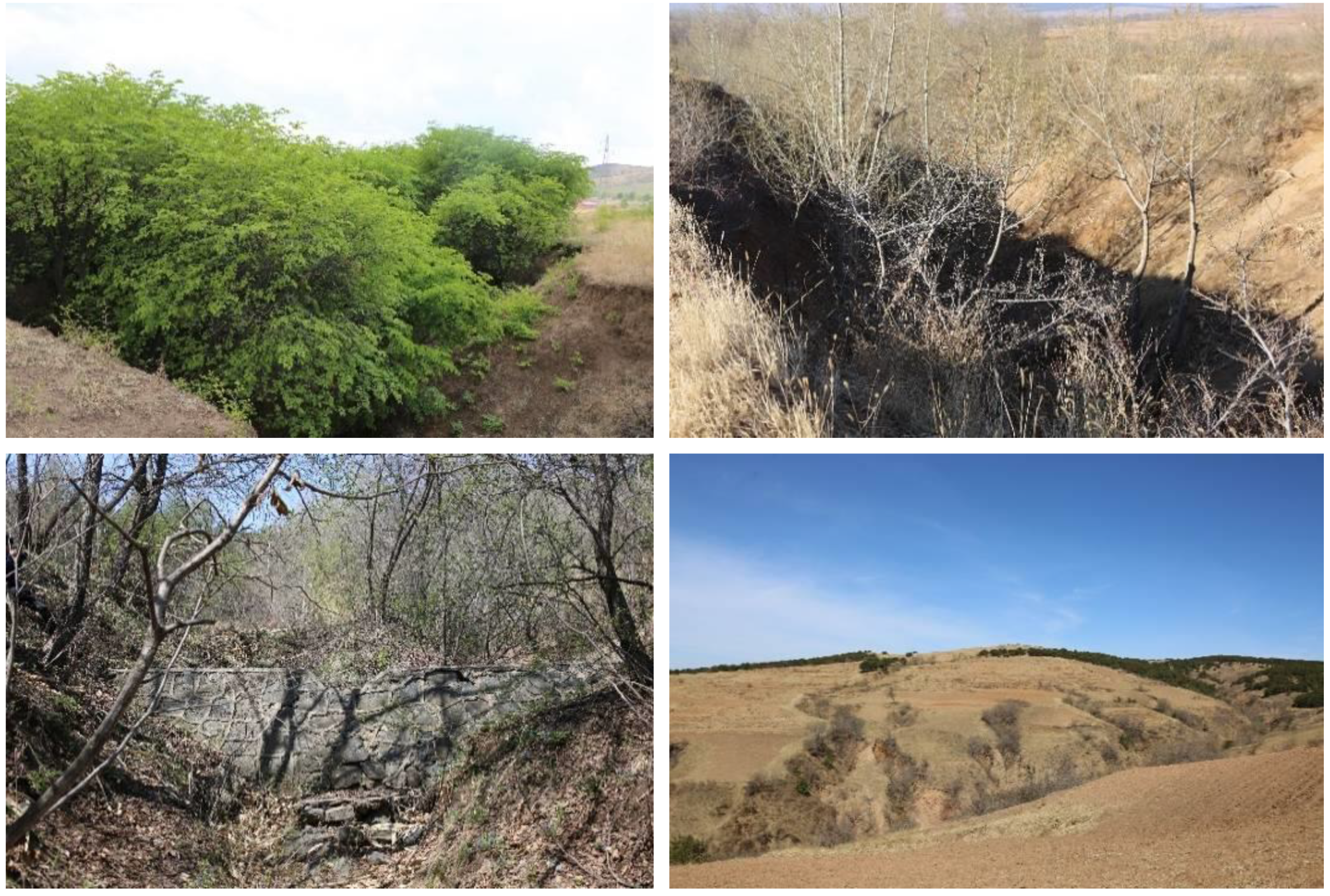
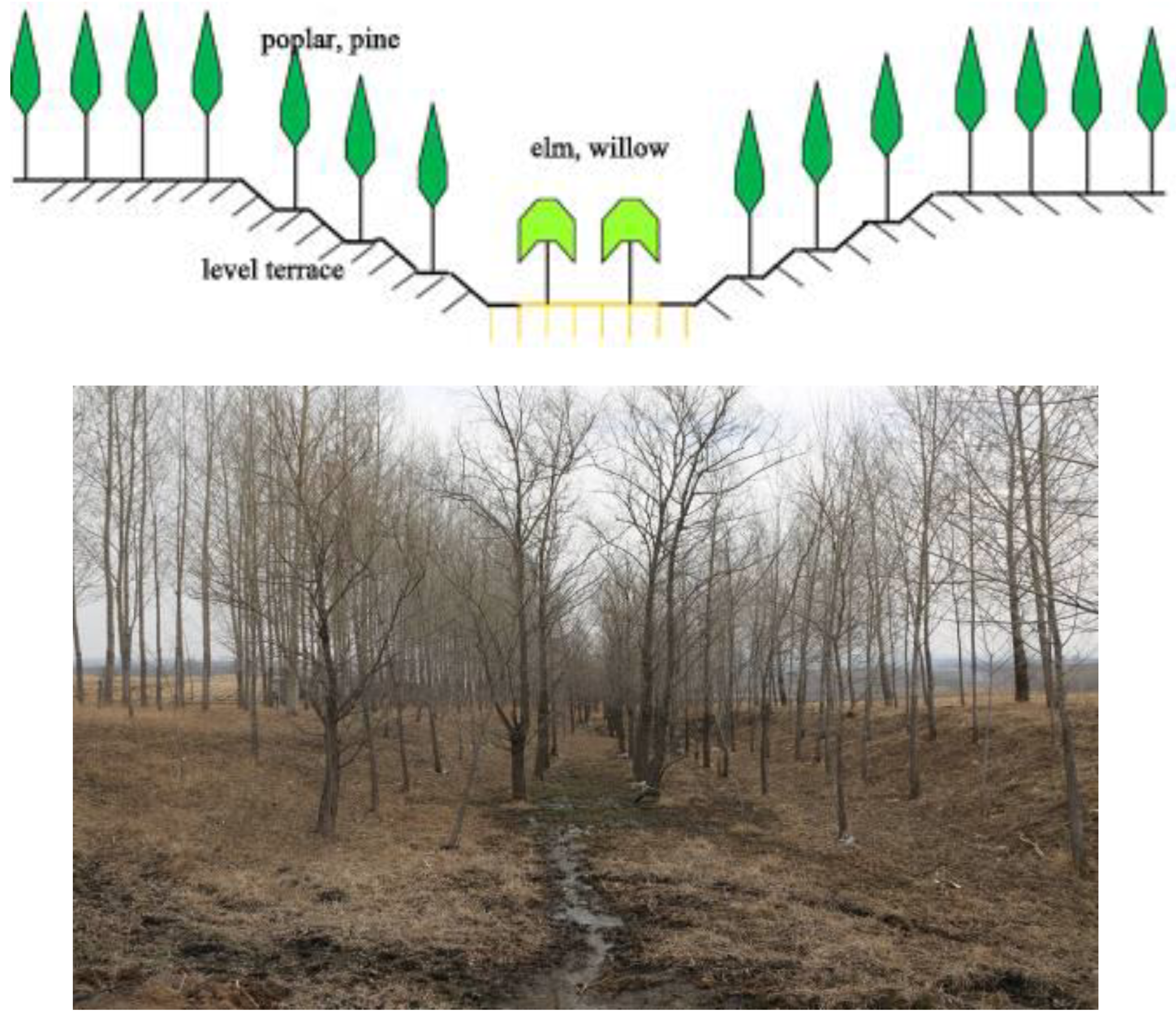
© 2019 by the authors. Licensee MDPI, Basel, Switzerland. This article is an open access article distributed under the terms and conditions of the Creative Commons Attribution (CC BY) license (http://creativecommons.org/licenses/by/4.0/).
Share and Cite
Liu, X.; Li, H.; Zhang, S.; Cruse, R.M.; Zhang, X. Gully Erosion Control Practices in Northeast China: A Review. Sustainability 2019, 11, 5065. https://doi.org/10.3390/su11185065
Liu X, Li H, Zhang S, Cruse RM, Zhang X. Gully Erosion Control Practices in Northeast China: A Review. Sustainability. 2019; 11(18):5065. https://doi.org/10.3390/su11185065
Chicago/Turabian StyleLiu, Xiaobing, Hao Li, Shengmin Zhang, Richard M. Cruse, and Xingyi Zhang. 2019. "Gully Erosion Control Practices in Northeast China: A Review" Sustainability 11, no. 18: 5065. https://doi.org/10.3390/su11185065
APA StyleLiu, X., Li, H., Zhang, S., Cruse, R. M., & Zhang, X. (2019). Gully Erosion Control Practices in Northeast China: A Review. Sustainability, 11(18), 5065. https://doi.org/10.3390/su11185065







